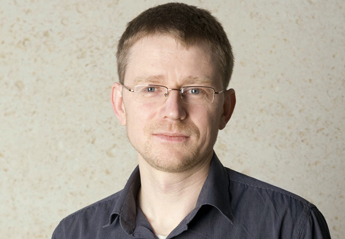
Scientific Discipline
Biochemistry, Structural Biology
Related Links
Host Institution
International Institute of Molecular and Cell Biology
Current Position
Dr. Nowotny is a group leader at the International Institute of Molecular and Cell Biology, Warsaw, Poland.
Current Research
Structural and Mechanistic Studies of Nucleic Acid Processing
Research
Biography
Part science, part alchemy, and part guessing game, X-ray crystallography is both a boon and a bane for scientists trying to unravel the structure of a protein. Frustration can surface in the very first step, when researchers must turn a protein into a crystal, a process that can take days or decades.
“You mix your protein with hundreds of different chemicals,” says Marcin Nowotny, a researcher who speaks from experience. The right combination yields a beautiful crystal; the wrong one yields a useless residue. “It’s trial and error,” he says, “and there’s also a lot of luck involved.” Still, he wouldn’t want to be doing anything else.
Nowotny, a biochemist at the International Institute of Molecular and Cell Biology in Warsaw, Poland, can’t remember a time when he didn’t want to be a scientist. As a child, “I would mix things and pretend I was doing experiments,” he says. By the late 1990s, he was a doctoral student conducting real experiments at the Nencki Institute of Experimental Biology in Poland, where his interest in crystallography began. “I realized that structures provide an incredible amount of information about how proteins work,” he says.
To reap the benefits of the technique, however, Nowotny needed training. In 2003, he went to the laboratory of Dr. Wei Yang at the National Institutes of Health in Bethesda, Maryland, to learn the intricacies of X-ray crystallography. He began working with nucleases, enzymes that cut apart DNA and RNA. He focused on RNase H, a nuclease that plays a crucial role in the replication of retroviruses like HIV.
To replicate, retroviruses must convert their single-stranded RNA into double-stranded DNA, which can then be integrated into the host cell’s genetic material. At one intermediary step, an RNA–DNA hybrid is formed. RNase H recognizes these hybrids and snips off the RNA portion, enabling the virus to create the second strand of DNA.
Scientists published the first structure of RNase H two decades ago. But Nowotny wanted to see how the enzyme attached to the RNA–DNA hybrid. In 2005, after a year and a half of painstaking experiments, he produced a crystal that captured both. But that was just the first step. Next, he directed a thin beam of X-rays at the crystal, collected images of the resulting diffraction pattern, and then used computer software to reconstruct the protein’s structure.
A protein’s shape can provide clues about its function. Nowotny’s crystal, for example, revealed “how RNase H binds, how it recognizes this RNA–DNA hybrid, and what chemical reaction it uses to actually perform the cut,” he says. But the benefit goes beyond basic science. Protein structures can be a big help for drug developers. Rather than screening thousands or even millions of compounds, they can instead design medicines that bind tightly to a given protein. In the case of RNase H, drugs could potentially be developed to interfere with the enzyme, thus preventing viral replication.
In 2008, Nowotny moved back to Warsaw to start his own laboratory at the International Institute of Molecular and Cell Biology. He began working on the structure of another RNase H, one that removes chunks of RNA mistakenly incorporated into DNA during cell division. This enzyme, called RNase H2, is critical to health. Children with mutations in the gene encoding this protein develop a severe autoimmune disease called Aicardi–Goutières syndrome (AGS). In 2010, Nowotny and his colleagues determined the structure of bacterial RNase H2 as it bound to an RNA–DNA hybrid as well as the structure of the human version of the enzyme. The team used the structures to explain how the mutations that lead to AGS might affect the enzyme’s activity.
Nowotny plans to continue investigating enzymes that act on RNA and DNA. He has taken a special interest in deadenylases—enzymes that kick start RNA degradation, an essential cellular process. “We don’t really understand how they work, or what they look like,” he says. By revealing the crystal structures of deadenylases, he hopes to get a view into their mechanisms.
It’s uncertain how long the work might take, Nowotny says. After all, crystallography can be a time-consuming, fraught endeavor. But the satisfaction that comes with discoveries more than makes up for any frustration. “Crystallography has this incredible eureka moment. All of a sudden you start seeing your atoms, then your structure,” he says. “And you realize that you’re the first person in the world to see it.”
Articles & News
Research Papers
Selected Research Papers



